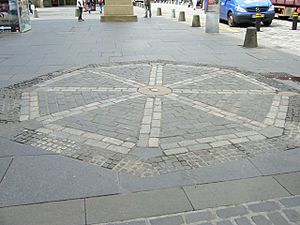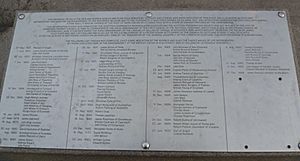Hugh Mackail facts for kids
Hugh Mackail (born around 1640 – died 1666) was a young Scottish minister. He is remembered as a martyr, meaning he died for his religious beliefs. He was born near Edinburgh, Scotland. His father, Matthew Mackail, was also a minister.
Hugh lived with his uncle, who was a minister in Edinburgh. He went to the University of Edinburgh and studied to become a minister. He was very good at his studies and finished university in 1658.
Contents
Early Life and Ministry
After university, Hugh worked for Sir James Stuart, who was a important leader in Edinburgh. In 1661, when he was just 20 years old, Hugh was allowed to preach. He quickly became known for his powerful sermons.
In September 1662, Hugh gave a sermon in Edinburgh. He spoke about how the church in Scotland was being treated unfairly. He said it was like being persecuted by a "king on the throne," a "powerful person in the government," and a "traitor in the church."
This upset the government and church leaders. They thought he was talking about King Charles II and other important people. A group of soldiers was sent to arrest him.
Escape and Return
Hugh managed to escape and hid at his father's house. Later, he went to Holland to stay safe. He lived there for about four years and continued his studies.
After a few years, Hugh returned to Scotland. He mostly stayed at his father's home. In November 1666, he joined a group of people called the Covenanters. These Covenanters were fighting for their right to worship freely.
The Covenanters' Uprising
The Covenanters believed in a specific way of running the church in Scotland. They wanted the church to be led by ministers and elders, not by bishops appointed by the king. This was a big disagreement with the king and his supporters.
Hugh joined the Covenanters in their march. However, he was not very strong and became ill after nine days. He had to leave the group and head back home.
Arrest and Torture
On his way back, Hugh was arrested. He was taken to Edinburgh and put in a prison called the Tolbooth. He was brought before the council many times. During this time, he was tortured to make him give up information.
Hugh's cousin, Matthew Mackail, tried to help him. He asked Archbishop Sharp, a powerful church leader, to intervene. But it did not work.
Trial and Execution
On December 18, Hugh was brought to court with three other people. He spoke bravely to the court. He talked about the promises the people of Scotland had made to God. He also spoke about how important the Presbyterian church was.
The king's lawyer stopped him, saying he was not on trial for his beliefs, but for rebellion. Hugh was found guilty of treason, which is a serious crime against the government. He was sentenced to be hanged.
His Final Moments
Hugh Mackail was hanged at the market-cross in Edinburgh on December 22, 1666. He was only 26 years old. Many people came to watch, and they were very sad. It was said that "not one dry cheek" could be seen in the crowd.
Before he died, Hugh spoke to the crowd. He blamed the church leaders for the persecution. He said he was ready to die for God's cause and for the freedom of the church in Scotland.
Some people believed that a letter from the king arrived shortly after his execution. This letter might have stopped more executions, but it was supposedly held back by the Archbishop.
Hugh Mackail was buried in Greyfriars Kirkyard in Edinburgh. People remembered him as a kind, religious, and very smart person.
A Character in a Book
The famous writer Sir Walter Scott created a character named Ephraim Macbriar in his book Old Mortality. This character is thought to be based on Hugh Mackail, though it's a changed version of him.




